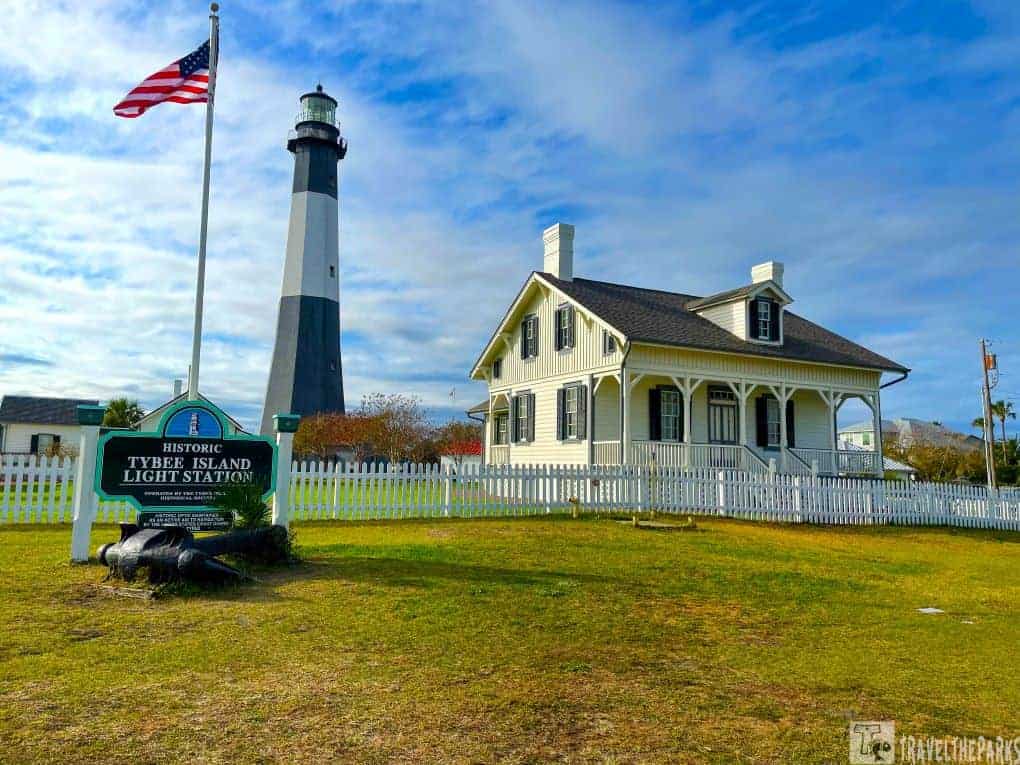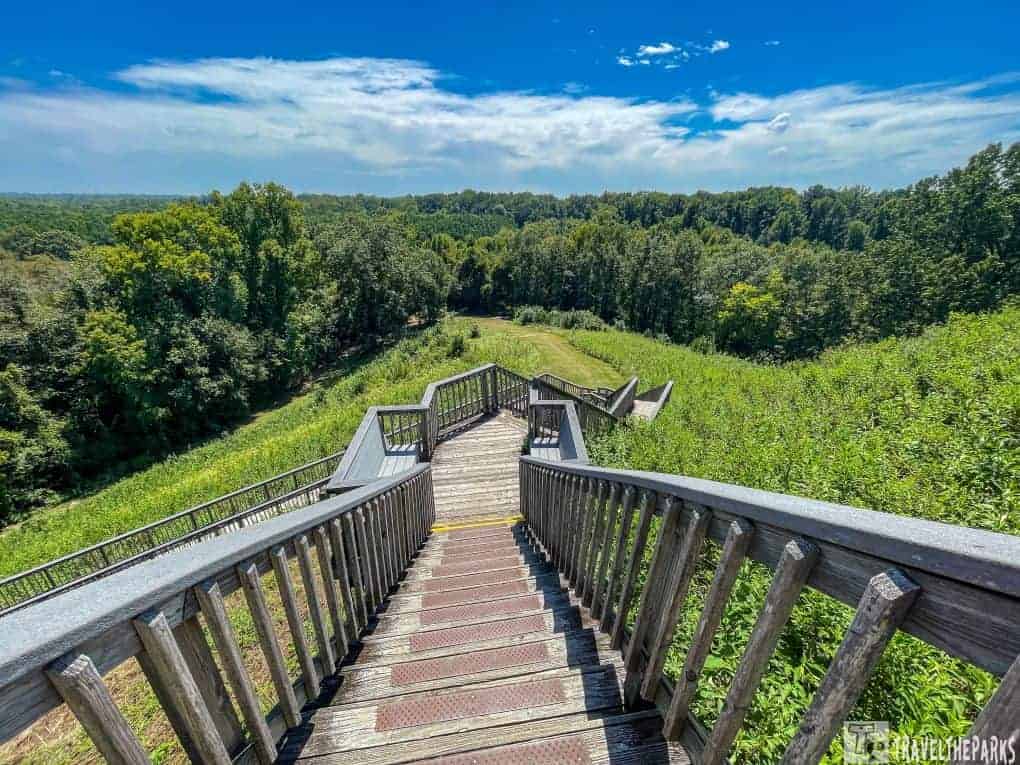The Tybee Island Light Station is a historic lighthouse on Tybee Island, near Savannah, Georgia. What’s important to know about Tybee Island Light Station is that it was first built in 1736, but has been rebuilt and renovated several times since then. The current structure, which stands at 150 feet tall, dates back to 1867. It is one of the oldest and tallest lighthouses in the country.

Besides its historical significance, the Tybee Island Light Station is also a popular tourist destination. It attracting visitors from around the world. Beautiful parks and beaches surrounded it, and is a favored spot for bird-watching, fishing, and other outdoor activities. We hope the following information provides important insight about Tybee Island Light Station.
This post may contain affiliate links, meaning if you purchase something through one of these links, we may earn a small commission at no extra cost to you! Read the full disclosure policy here.

The Tybee Island Lighthouse has played an important role. It has been guiding mariners into the Savannah River and is a well-known landmark on the Georgia coast. It is open to the public for tours. Visitors can climb to the top for panoramic views of the surrounding area.
Table of Contents
Planning a trip to Tybee Island Light Station and Museum: Directions
Tybee Island Light is a lighthouse next to the Savannah River Entrance, on the northeast end of Tybee Island, Georgia. From Savannah take Highway 80 East which ends on Tybee Island. Take a left at the first stoplight on the island, which is Campbell Avenue. At the end of Campbell Avenue, take a left onto Van Horne. Your first right is Meddin Drive. Take a right and stay on Meddin Drive until you reach the lighthouse parking area. Location address: 30 Meddin Drive, Tybee Island, Georgia 31328.
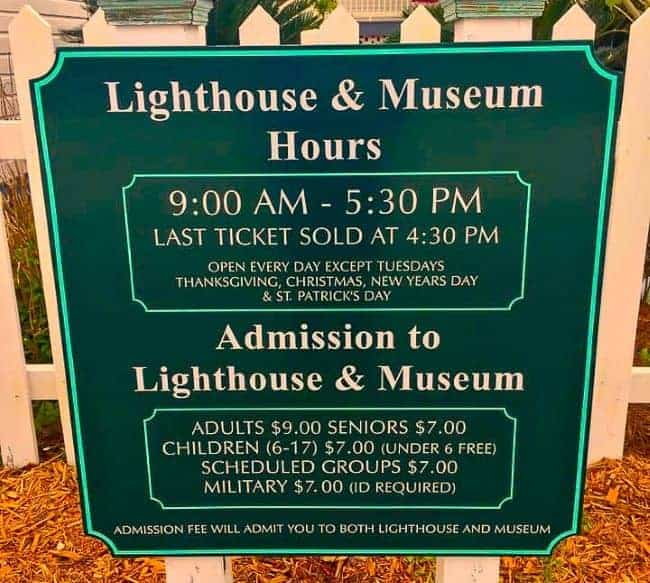
What’s Important to Know about Visiting Tybee Island Light Station?
With your paid entry, you get access to everything on the 5-acre site. This includes the Lighthouse, the Head Keeper’s Cottage, the 2nd Assistant Keeper’s Cottage, the Summer Kitchen and the WWII Battery Museum across the street. It includes 2-hours of parking. Since 2002, the Tybee Island Historical Society maintains the light station. The museum also offers educational programs and events for visitors of all ages, including guided tours of the Tybee Island Lighthouse, lectures and workshops, and special events. A downloadable brochure is available from the Historical Society.
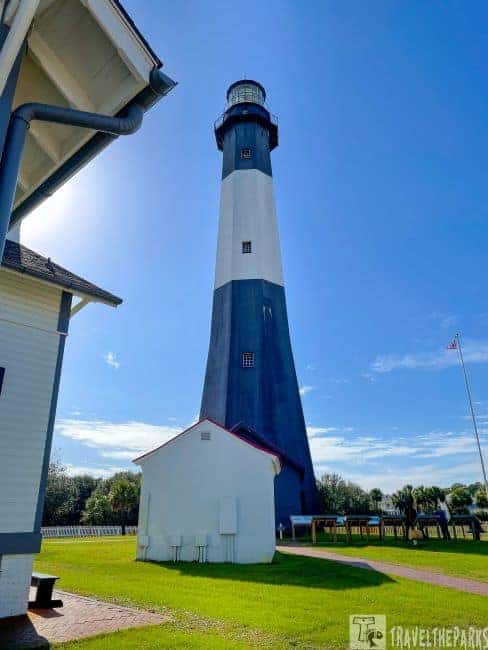
Tybee Island Light Station History Guide
The current lighthouse is the fourth tower at this station, though neither of its first two predecessors were lit. James Oglethorpe ordered the building of the first tower in 1736. An octagonal wood framed building, nearly 90 feet high, with a bottom width of 25 feet and a top width of 1.5 feet. In August 1741, a hurricane destroyed the tower. One year later, Thomas Sumner built a 94-foot wood/stone tower topped by a 30-foot flagpole. This 2nd tower was short-lived when it succumbed to the eroding shoreline.
John Mullryne constructed the third tower in 1773. This 100-foot-high structure was located well inland from the shifting shoreline. Constructed with a sturdy stone exterior and wooden interior staircases/landings. Installed by the government in 1791, it was the first lighthouse on the island to be lit by spermaceti candles & reflectors. They installed Fresnel lenses in 1857.

Civil War Impacts to Tybee Island Lighthouse
Confederate forces burned a portion of the light during the Civil War in 1862. They removed the lens while retreating to Fort Pulaski from the Union soldiers. Rebuilding the light began by using the 60 foot intact base in 1866. This time, the lighthouse’s final height was 145 feet. A cholera outbreak delayed some of the construction. For the first-order station, masonry and metal were used as fireproof materials. Refitted with a brand-new Fresnel lens. During a hurricane in 1871, the main tower suffered severe damage. During this refit, they replaced wooden interior elements with iron.
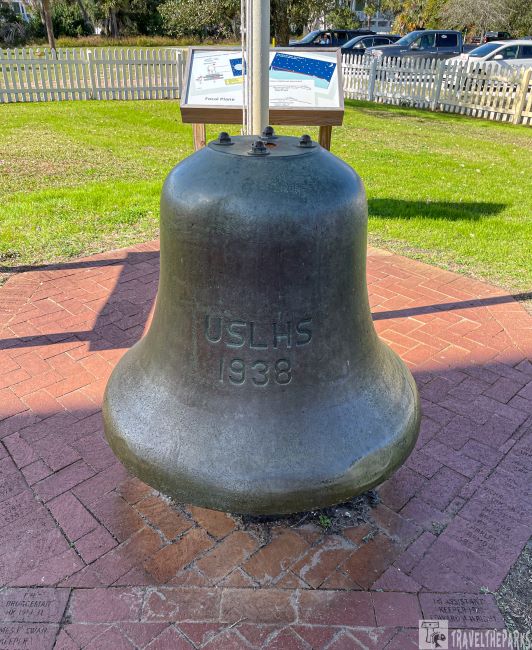
The tower suffered further damage to its lens and brickwork because of the Charleston earthquake of 1886. However, it was immediately repaired. They converted the Tybee Island lighthouse lamp to electricity in 1933 due to economizing measures after the 1929 stock market crash. The electrification of the tower and the reduction of the station’s keeper to only one. They automated the beacon in 1972. The beacon is still a functioning navigational aid, still using its original lens. The site is open to the public and has a lighthouse and keepers’ houses, as well as auxiliary buildings.

What to see at Tybee Island Lighthouse on a Self-guided Tour
A self-guided tour of the Tybee Lighthouse & Museum is a great way to learn about the history of the area and experience one of the most iconic landmarks in Georgia.
Stop #1 – Garage/Gift Shop
Your self-guided tour begins at the Gift shop. The lighthouse is open Daily, except Tuesday, from 9:00 am to 5:30 pm. Closed Thanksgiving Day, Christmas Day, New Year’s Day and St. Patrick’s Day. Current admission is $10 for adults/$8 for seniors, $8 for Children 6-17 yrs, under 5 yrs free. Military discounts are available. Originally used as the lighthouse garage built in 1934, it is now the gift shop where you purchase your entrance ticket.


Stop #2-Fuel Storage Building
The first building is the Fuel Storage Building. They built it in 1890. They used this small shed to store fuel for the lighthouse. The red roof signifies that it holds flammable materials such as kerosene used to light the lamps. Construction materials such as brick and metal were used to prevent fire. They used a small cupola at the top as a ventilation system to help keep the kerosene fumes from building up inside the building.

Restored in 2020 to its original condition, it contains exhibits on the history of the lighthouse and its role in guiding ships through the treacherous waters of the Savannah River and the Atlantic Ocean.
Inside, we learned about fueling the lamps, the challenges of maintaining the light station in the early 1900s, and the history of the Tybee Island Light Station itself.
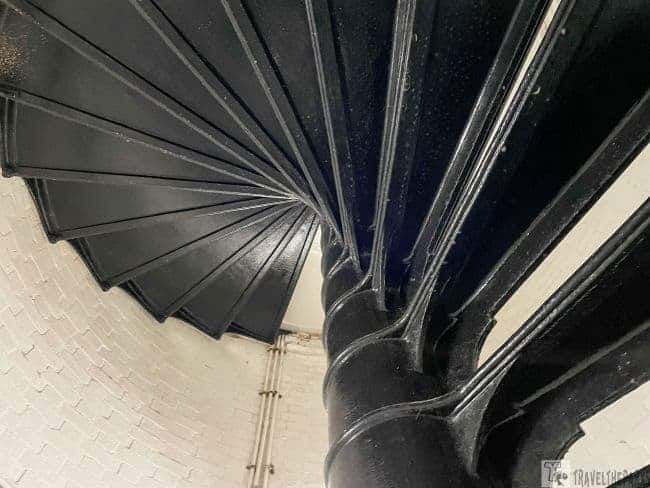
Stop #3-How Many Steps to the Top of Tybee Island Lighthouse?
Once you have finished exploring the fuel storage building and outside exhibits, we head inside to begin your climb up the lighthouse.
We walked up 178 steps to get to the upper catwalk at the top of the light (Climbing up might be difficult). They placed platforms between each flight of 25 stairs as the stairway rotates around the circular structure. At every landing is a window so we could check out the view of the surrounding grounds.
Once you reach the top observation deck, take some time to enjoy expansive 360°panoramic views of the island and the surrounding area. You’ll be able to see for miles in every direction. The day we visited it was rather WINDY. Because I have a fear of heights, I stayed pressed against the wall, clinging to the brick. I did, however, make it all the way round the catwalk before dashing back inside. Barry has no fear of heights and took pictures. I can’t imagine the lightkeeper having to go up and down several times a day!
Note: they limit the number of people that can be in the lighthouse at one time
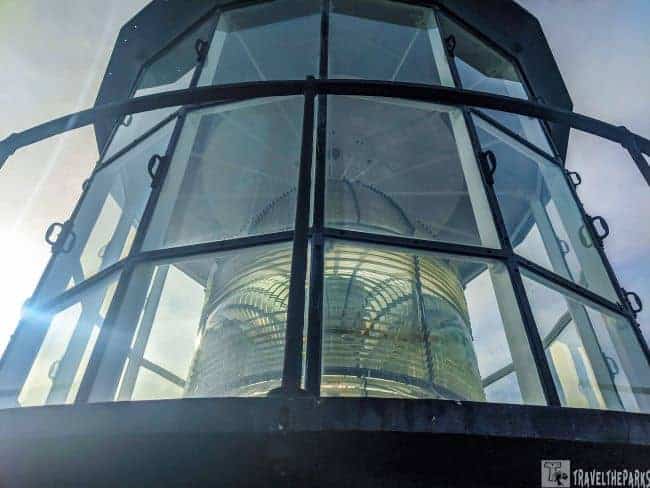
A Beacon of Light: The Lantern Room
This beacon has been lit since 1791. An example lens is on display at the base of the station. These lenses, developed by Augustin-Jean Fresnel, feature flat surfaces and concentric rings, which allow them to produce an extremely bright beam of light. Automated in 1972, a new beacon replaced the Fresnel lenses in 2002. Today, this fixed white electric light of 70,000 candlepower has an extraordinary range of 18-miles.
Lighthouse keepers were individuals who maintained and operating the lighthouse. They played a vital role in guiding ships safely through the waters off the coast. Walking through the lighthouse keepers’ cottage, the period artifacts impressed upon us what daily life would have been like for the keepers.

Stop #4-2nd Assistant Keepers Cottage-circa
Our first cottage stop on our grounds tour was the 2nd Assistant Cottage. It is believed that they constructed the cottage from the remains of the 1861 barracks. Assigned in 1867 as the 2nd assistant keeper’s cottage. It originally comprised only four small rooms, but a fifth room, a summer kitchen, was added later. The year 1916 saw the addition of electricity and 1907 they enclosed the porch for a bathroom. Today, the 2nd Assistant Keepers Cottage features a continuous loop of a 15-minute video detailing the history of the lighthouse.

Stop # 5 Head Keepers Cottage-Keeper of the Light-circa 1881
They built this cottage the largest and most prominent historic structure in 1881. It was used to house the head keeper and his family.
The wood-framed cottage is a two-story with a gabled roof and a beautiful wrap-around porch. It is a beautiful example of the Victorian-era Stick Style architecture. You definitely get the feeling they designed it to be functional and comfortable. Some of the outstanding features are large windows that would have overlooked the water and a fireplace for heating in the colder winter months.

We explored the various rooms. They have meticulously furnished each with period-appropriate furniture and accessories, providing a realistic glimpse into life at the light station during the late 1800s and early 1900s. I found it most interesting while reading one of the information kiosks the detail the stories of each of the different head lighthouse keepers. I was most impressive learning how the last light keeper lived with his family of six on the property.
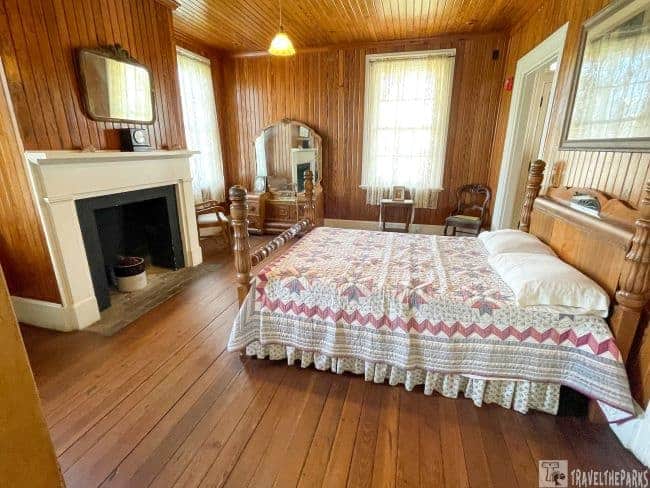
Tybee Light Station Keeper Duties
The lighthouse keeper’s duties included maintaining the light, cleaning and repairing the lens and other equipment, and keeping the lighthouse grounds and buildings in good condition. In addition, lighthouse keepers were often responsible for monitoring weather and keeping a lookout for ships in distress, and for communicating with ships to provide them with information and guidance.
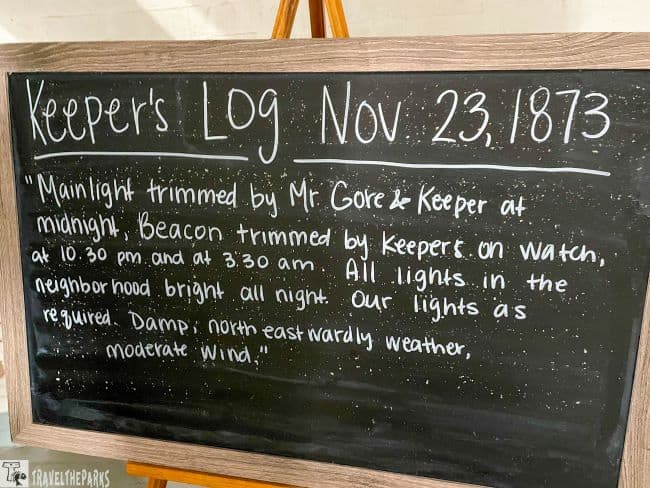
Lighthouse keepers were required to have a strong work ethic, be self-sufficient, and be able to live and work in isolated and often challenging conditions. Despite the challenges, many lighthouse keepers took great pride in their work and regarded their duties as a calling.

Stop #6-Summer Kitchen & Garden-circa 1812
The Stick Style architecture of the Summer Kitchen was used to prepare meals until 1910. It is the oldest structure on the property. In the summer, all the keepers and their families used it to keep the heat out of the own cottage. Today, the small one room building contains exhibits on the history of the light station and the role of the summer kitchen in providing meals for the keepers and their families. I discovered that most of the artifacts came from various archaeological digs. Ammunitions,

The garden next to the Summer Kitchen is a beautiful example of a traditional kitchen garden, with rows of vegetables, fruit trees, and herbs.
Stop #7- 1st Assistant Keepers Cottage-circa 1885
It houses offices and it’s not open to the public

The Making of Fort Screven Battery Garland / Tybee Island Museum (circa 1898)
Across the street from the lighthouse stands Fort Screven-Battery Garland. The historical society has filled the Fort Screven’s Battery Garland museum with over 400 years of island history. These remnants and artifacts are worth exploring.
Fort Screven and the Endicott Period Batteries refer to a series of military fortifications and coastal defense structures on Tybee Island, near Savannah, Georgia. As the outbreak of the Spanish-American War approached, the United States built the fort as part of Georgia’s improved coastal defenses in the 1890s. Originally called Fort Tybee. They later renamed it to Fort Screven in honor of General Joseph Screven, hero of the Revolutionary War, killed at Midway Church in 1778.
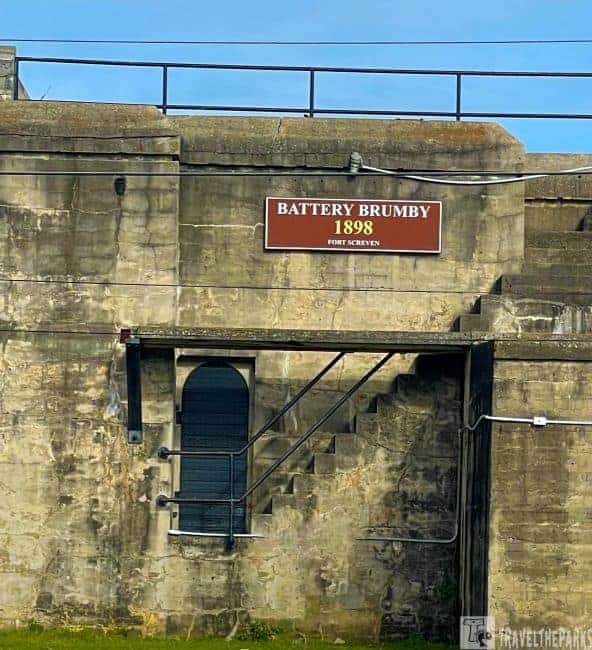
Endicott Period (1890-1910)
The Endicott Period was a time of modernization in the US military and saw the construction of new fortifications, including the batteries on Tybee Island, which protected the coast and river from naval attack.
The Endicott Period Batteries Garland, Brumby and Habersham on Tybee Island comprised several (7) large concrete gun emplacements and supporting structures, as well as underground magazines and utility buildings. They equipped the batteries with large caliber 8-Inch guns. They outfitted battery Garland with a huge 12-inch “non-disappearing” rifled long-range cannon. The battery had it mounted on top of it. These were an essential part of the coastal defense system of the United States. These historic fortifications serve as a reminder of the decisive role that Tybee Island played in the coastal defense of the United States and the military history of the country.
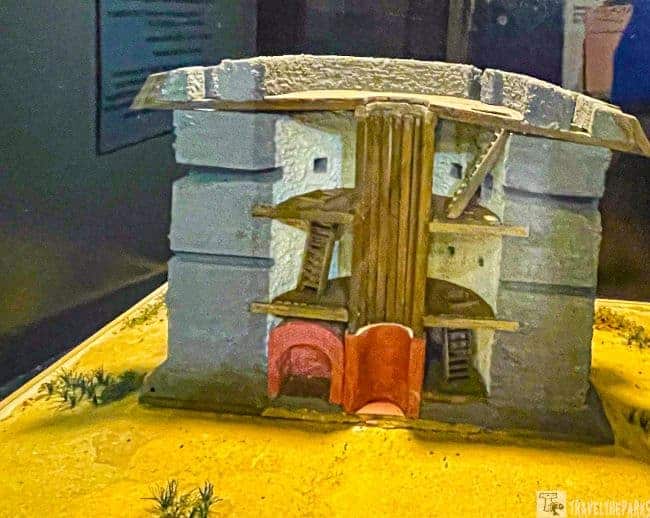
Note: There’s a water bottle refilling station to the side of the bathroom- so bring your water bottle.
Visiting Tybee Island Light Station: Historical Exhibits Inside Battery Garland
Today, they have preserved three of the 1898 Endicott Period Batteries on Tybee Island. Only one, battery Garland, is open to the public for tours and education. The others are privately held. These historic structures serve as a reminder of the important role that Tybee Island played in the coastal defense of the United States and the military history of the country.
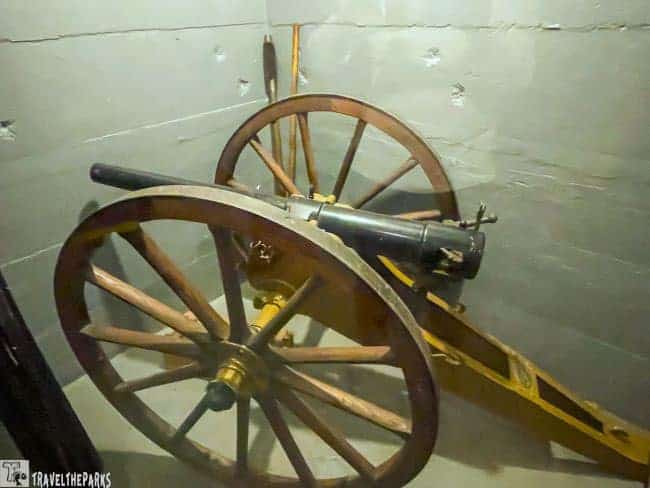
Most of the lower rooms, which now contain the Museum’s exhibits, were used to store smokeless gunpowder and projectiles, each weighing over 700lbs. The Battery served as part of the United States’ Coastal Defense Systems until they decommissioned it in 1945. Battery Garland is operated by the Tybee Island Historical Society and has served as the Tybee Museum since 1962.
We learned a lot about the island’s history, walking through the endless exhibits of artifacts, photographs, and other historical items. They date from the early indigenous peoples through the civil war to today. Most nostalgic were the displays of the beach area in the 1950s and 1960s.
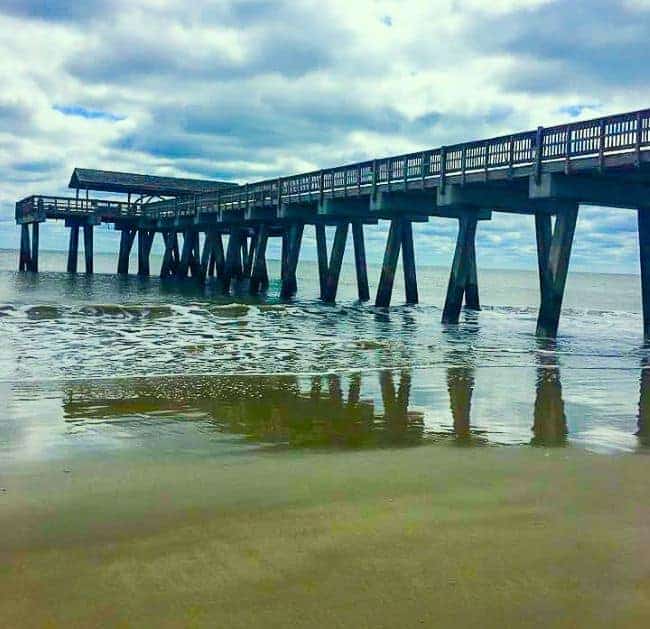
The Beaches of Tybee Island – The Pier & Pavilion
This island has magnificent beaches that are perfect for swimming, sunbathing, and water sports. The north beach across the street from the lighthouse station is a great spot for dolphin watching, bird-watching, and taking in the natural beauty of the surrounding area. There are several boat tours available on the island that offer dolphin watching tours. The sand dunes at North Beach are an important part of the island’s ecosystem, and we took a stroll to watch the sun dip below the horizon and enjoy the beautiful colors of the sky..
Note: If you plan to spend the day, pack plenty of water, snacks, sunscreen, bug spray, sunglasses, beach towels, and remember your camera.

Lookout over the south beach pier is a mere 3-miles from the museum. You can listen to the soft rush of the surf. The pier extends 1,500 feet into the Atlantic Ocean. We found it to have a great vantage point for fishing, people-watching, or enjoying the splendid ocean views. The pavilion, at the end of the pier, is it has a covered area that hosts concerts, events, and festivals throughout the year. The pavilion also includes a snack bar and restrooms for visitors’ convenience.
The Tybee Island Pier and Pavilion is open to the public year-round and is a public destination for both locals and tourists. Fishing from the pier is allowed with a valid Georgia fishing license, and visitors can rent fishing equipment on site.

What other things can I do near Tybee Island Light Station?
- Tybee Island Marine Science Center displays interactive exhibits and educational programs about the marine life and ecosystem of the island.
- Kayaking and paddleboarding: There are several rental shops on the island that offer kayaking and paddleboarding tours.
- Tybee Island Farmers Market is held on Saturdays and features fresh produce, local crafts, and live music.
- Tybee Island Crab Shack: This seafood restaurant is a must-visit for its famous crab dishes and casual, beachy atmosphere.

Best Dining Options on Tybee Island
There are many great restaurants on Tybee Island. Whether you’re in the mood for seafood, breakfast, or something more unusual, you will find something delicious to eat here. Our favorite was Chamacos. If you’re in the mood for some Mexican food while on Tybee Island. The restaurant is on the main thoroughfare, 1105 Highway 80 east. This eclectic restaurant serves a variety of Mexican dishes such as tacos, burritos, fajitas, and enchiladas. We chose an array of authentic street tacos, all were delightful! Chamacos is definitely worth checking out! Here are some of our other best suggestions for places to eat on Tybee Island:
- The Crab Shack at Chimney Creek is an iconic seafood restaurant. Know for its servings of the freshest seafood you can on the island. The outdoor seating is perfect for enjoying the beautiful views of Chimney Creek and the atmosphere is lively and fun.
- A-J’s Dockside Restaurant waterfront restaurant offers a wide variety of seafood dishes, including fresh local oysters and shrimp. They also have a great selection of beer and cocktails to complement any meal.
- The Breakfast Club is just what anyone would expect, a popular breakfast spot. Renown for serving up delicious Southern-style breakfast dishes, including pancakes, eggs, and bacon. The portions are generous and the prices are fair.
- North Beach Bar & Grill a beachfront restaurant, is directly across the street from the Tybee Lighthouse. With its casual atmosphere and great views of the ocean, it’s an ideal location for a light brunch. They have a large menu with plenty of options for seafood lovers and also offer a kids’ menu.
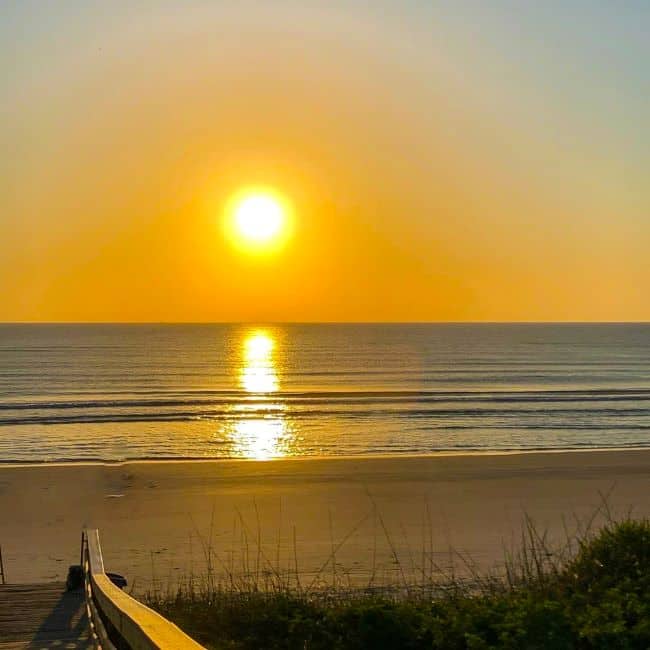
Final Thoughts: What’s Important to Know about Tybee Island Light Station & Museum?
Whether you’re looking for a relaxing getaway or an adventure-filled vacation, Tybee Island has it all. It served as a reminder of the important role that lighthouses and lighthouse keepers played in the history of the United States and the maritime heritage of Tybee Island. Make sure to add a trip to the light station to your travel bucket list and experience the charm and beauty of this coastal paradise. We combined our day with a side trip to Fort Pulaski National Monument and Fort Frederica National Monument.
Have you been to the Tybee Island Light Station? If you plan to visit, what are looking forward to seeing most? Please comment below. We love when you share your adventures with us!

